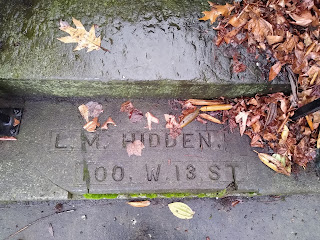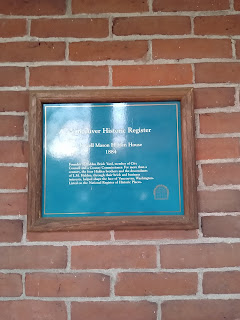The Hidden family has been prominent here since when Vancouver was a village in the 1860's. Initially working for the Hayden family (whom Hayden Island, where my old - very haunted - work boatyard is, named after), Lowell Mason Hidden purchased the land on 13th to 19th and Main Street's west side, where the Brickhouse Bar & Grill and other businesses remain today. He built a log cabin at 14th and Main Street around 1865 and married Mary Sherbon Eastman a few years after, bringing his brother Arthur west to WA with his new bride Mary.
Arthur Hidden planted the first prune tree in Clark County, Washington on 26th and Main. Lowell also was instrumental in railroad construction in the area.
 |
| Brickhouse approaching from North |
 |
| East (front) on Main St. |
 |
| 1977 was a good year. |
 |
| A literal walk through time behind the Brickhouse Bar |
 |
| The back of Brickhouse |
In 1871 Hidden Brick company was founded to provide the bricks for Mother Joseph's Providence Academy. The Academy still stands, and is currently in the middle of a gentrification dispute:
https://www.columbian.com/news/2020/jan/03/site-plan-for-vancouvers-providence-academy-moves-forward-intact/
The first brickyard was at 15th and Main, and it is estimated that over 60 million bricks were crafted there. Bricks sold for $8.00 per 1000 in the company's early days. Buildings created from these bricks include:
- The Providence Academy and Orphanage (400 E. Evergreen Blvd, mentioned above, built in 1873, currently used for event space.) Rumor has it Mother Joseph herself asked Hidden to establish a brick manufactory for this project.
- The St. James Cathedral (built 1885 - using 900,000 Hidden Bricks)
- The Columbia Hotel (3rd and Main street - Clark county's first elevator and telephone booth). Third Hidden brother Oliver came west to Vancouver to be a successful architect, along with a 4th brother Jackson, a fruit grower.
- Lowell M. Hidden House (Queen Anne style, built 1884, W. 13th and Main St. - now reopened as a Market/deli - https://www.columbian.com/news/2020/jan/10/market-and-deli-open-in-hidden-house-in-vancouver/)
- Masonic Temple (built 1886) - the Original was the Hayden Building on 5th and Franklin, used until 1886 - I need to track down where the old lodge is downtown, better first hit...
- The Carnegie Library (built 1909, 16th and Main, now Clark County Historical Museum)
- W. Foster Hidden House - Son of Lowell, next door (Georgian Revival style, built 1913, Also W. 13th and Main St. It is now a law office.)
- Hidden Brick House Barn (currently Urban Barnhouse vintage store, 1333 Washington St. https://www.visitvancouverusa.com/listing/urban-barnhouse-vintage-furniture-%26-garden/2777/)
Lowell Hidden served on the Council and County Commission. As a gift to the city of Vancouver, he donated his property at 16th and Main for a Public Library (Carnegie Library, mentioned above).
Lowell and Mary's sons, W. Foster and Oliver Hidden, took over the brickyard business in 1905 and continued until 1940 when Oliver died. W. Foster Hidden passed in 1963 and his son Robert Hidden continued the family business and local philanthropy. Robert purchased the above mentioned Providence Academy in 1969, saving it from destruction.
I'm saving Providence for its own post.
Okay, great, these are brick buildings and they're really old, why are they interesting to me? Because I have heard that every, single one of them on the list above is haunted. This got me on the path of why are all of these buildings created from Hidden Bricks haunted? Is it just age or is it something else going on? When you think about how these bricks were actually made, dug out of the ground here and turned into something, maybe the clay is contributing.
Note: in 1905 Hidden Bricks stopped being hand made and began being machine-made. The Carnegie Library (built 1909) is rumored to be haunted, so the machining of bricks vs hand making them all does not to seem to affect my working theory that the bricks are contributing to the hauntings in these buildings.
Here's what specifically the bricks are made of:
"The Hidden Brick Co., at 2610 Kaufmann Ave, Vancouver, Wash., uses a loamy alluvial silt that overlies the gravelly phase of the lacustrine deposits. Only the upper few feet of the surface materials is used for raw material at this plant. it is probably alluvial silt deposited during the downcutting of the lacustrine deposits, with perhaps some admixed colluvium" (p 106 - taken from "Geology of Portland, Oregon and Adjacent Areas: US Geological Survey Bulletin 1119," Trimble, D.E, 1963).
If you want to learn about HOW they made these bricks, like I did, here's a great source. It's got amazing old photos of the process and how the yards used to look when they were in operation:
http://www.washingtonbricks.com/brick.hiddenbm.html
Other random current locations of Hidden bricks close by to investigate:
- Grass Valley Park, Camas, WA
- Fargher Lakehouse Restem.
Jeremy Puma, co-founder of Liminal.Earth, helped me come up with a great idea to experiment with the dirt - making a battery and seeing if the soil from where the bricks were made is somehow different than other soils from the area.
How to make a soil battery: HERE
Would love to hear from anyone else that has ideas how I can experiment with the soil samples.
I'm also going to see if I can verify the supposed hauntings at as many places built with these bricks as I can.

















No comments:
Post a Comment